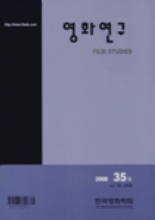- 영문명
- Buddhist Propensity of Buddhist Movie Mandala, The Avatamska Sutra (Hwa-eomgyeong), Spring, Summer, Fall, Winter and Spring
- 발행기관
- 한국영화학회
- 저자명
- 이효인
- 간행물 정보
- 『영화연구』제35호, 401~431쪽, 전체 31쪽
- 주제분류
- 예술체육 > 예술일반
- 파일형태
- 발행일자
- 2008.03.31

국문 초록
영문 초록
This study, “Buddhist Propensity of Buddhist Movie Mandala, The Avatamska Sutra (Hwa-eomgyeong), Spring, Summer, Fall, Winter and Spring” is for Korean Buddhist movie which doesn't be produced so much but occupies an important position. There are Confucianism, Buddhism and Taoism as Korean traditional spirits. These spirits have an effect on living and thought ways of Koreans until current high scientific civilization period. It's not possible for me to classify Korean Buddhist movie as one of genre but it has been hot issue whenever producing and paid much attention at international film festival in abroad as a branch of movies which have been producing since liberation. Especially, Mandala by Kwontaek Yim, The Avatamska Sutra (Hwa-eomgyeong) by Sunwoo Jang and Spring, Summer, Fall, Winter and Spring by Kiduk Kim, these have attracted public notice. Mandala is a film to pursuit acute criticism against to Buddhism as well as true spirit awakened by designating depraved monk one diligent Buddhist monk. Hwayumkyeong has been adapted from The Avatamska Sutra which is the representative Sutra, it has much importance to social practice and expresses Buddhism spirit which doesn't have any distinctions. Spring, Summer, Fall, Winter and Spring is a film to represent painful side of life with a side of Buddhism spirit, based on transmigrationism and karma of life. These films are very good at utilizing important side of Buddhism, appropriated to their theme and subject matter each and commonly violating or transgression of the Buddhist commandments have been regarded as major motives to progress the theme idea and drama. Due to these reasons, it's true that Mandala has a limitation to think Buddhism, focused on transgression of the Buddhist commandments excessively, Hwayumkyeong has a limitation to weaken centered themes and Spring, Summer, Fall, Winter and Spring has a limitation to incline to nihilism. In despite of these minor weak points, Korean Buddhism movies which have been produced since 1980's, show rapid maturity compared to previous movies which handled Buddhism subject or anecdote. Hopefully this study would be used for that Buddhism which have been expressed on these different 3 movies show popular and deep figures.
목차
1. 연구 목적
2. 1980년대 이후 한국 불교영화
3. 불교 교리와 ‘불교성’ 문제
4. 〈만다라〉, 〈화엄경〉, 〈봄 여름 가을 겨울 그리고 봄〉 등의 불교적 표현
5. 맺음말 (범계(犯戒)의 모티브의 한계)
키워드
해당간행물 수록 논문
참고문헌
최근 이용한 논문
교보eBook 첫 방문을 환영 합니다!

신규가입 혜택 지급이 완료 되었습니다.
바로 사용 가능한 교보e캐시 1,000원 (유효기간 7일)
지금 바로 교보eBook의 다양한 콘텐츠를 이용해 보세요!


